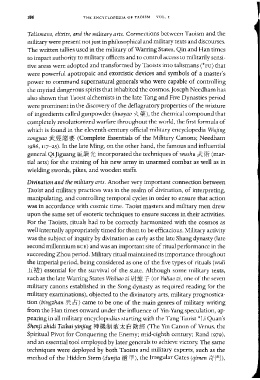Page 226 - The Encyclopedia of Taoism v1_A-L
P. 226
r86 THE ENCYCLOPEDIA OF TAOISM VOL. I
Talismans. elixirs. and the military arts. Connections between Taoism and the
military were present not just in philosophical and military texts and discourses.
The written tallies used in the military of Warring States. Qin and Han times
to impart authority to military officers and to control access to militarily sensi-
tive areas were adopted and transformed by Taoists into talismans (*FU) that
were powerful apotropaic and exorcistic devices and symbols of a master's
power to command supernatural generals who were capable of controlling
the myriad dangerous spirits that inhabited the cosmos. Joseph Needham has
also shown that Taoist alchemists in the late Tang and Five Dynasties period
were prominent in the discovery of the deflagratory properties of the mixture
of ingredients called gunpowder (huoyao 1< ~). the chemical compound that
completely revolutionized warfare throughout the world. the first formula of
which is found in the eleventh-century official military encyclopedia Wujing
zongyao lEUJH!~I~ (Complete Essentials of the Military Canons; Needham
1986. 117-25). In the late Ming. on the other hand. the famous and influential
general Qi Jiguang lilt ~)t incorporated the techniques of wushu i~ it} (mar-
tial arts) for the training of his new army in unarmed combat as well as in
wielding swords. pikes, and wooden staffs.
Divination and the military arts. Another very important connection between
Taoist and military practices was in the realm of divination, of interpreting,
manipulating. and controlling temporal cycles in order to ensure that action
was in accordance with cosmic time. Taoist masters and military men drew
upon the same set of esoteric techniques to ensure success in their activities.
For the Taoists. rituals had to be correctly harmonized with the cosmos as
well internally appropriately timed for them to be efficacious. Military activity
was the subject of inquiry by divination as early as the late Shang dynasty (late
second millennium BeE) and was an important site of ritual performance in the
succeeding Zhou period. Military ritual maintained its importance throughout
the imperial period. being considered as one of the five types of rituals (wuli
.li~) essential for the survival of the state. Although some military texts.
such as the late Warring States Weiliao zi tM ~ of (or Yuliao zi. one of the seven
military canons established in the Song dynasty as required reading for the
military examinations), objected to the divinatory arts. military prognostica-
tion (bingzhan ~ ~) came to be one of the main genres of military writing
from the Han times onward under the influence of Yin-Yang speculation. ap-
pearing in all military encyclopedias starting with the Tang Taoist *Li Quan's
Shenji zhidi Taibai yinjing i$ ~ fM IZ&"* El ~ ~~ (The Yin Canon of Venus, the
Spiritual Pivot for Conquering the Enemy; mid-eighth century; Rand 1979),
and an essential tool employed by later generals to achieve victory. The same
techniques were deployed by both Taoists and military experts. such as the
method of the Hidden Stem (dunjia Jm 1'(3). the Irregular Gates (qimen 1§f pI]).

